Xiangjun Gao
GeometryCrafter: Consistent Geometry Estimation for Open-world Videos with Diffusion Priors
Apr 01, 2025Abstract:Despite remarkable advancements in video depth estimation, existing methods exhibit inherent limitations in achieving geometric fidelity through the affine-invariant predictions, limiting their applicability in reconstruction and other metrically grounded downstream tasks. We propose GeometryCrafter, a novel framework that recovers high-fidelity point map sequences with temporal coherence from open-world videos, enabling accurate 3D/4D reconstruction, camera parameter estimation, and other depth-based applications. At the core of our approach lies a point map Variational Autoencoder (VAE) that learns a latent space agnostic to video latent distributions for effective point map encoding and decoding. Leveraging the VAE, we train a video diffusion model to model the distribution of point map sequences conditioned on the input videos. Extensive evaluations on diverse datasets demonstrate that GeometryCrafter achieves state-of-the-art 3D accuracy, temporal consistency, and generalization capability.
StereoCrafter: Diffusion-based Generation of Long and High-fidelity Stereoscopic 3D from Monocular Videos
Sep 11, 2024



Abstract:This paper presents a novel framework for converting 2D videos to immersive stereoscopic 3D, addressing the growing demand for 3D content in immersive experience. Leveraging foundation models as priors, our approach overcomes the limitations of traditional methods and boosts the performance to ensure the high-fidelity generation required by the display devices. The proposed system consists of two main steps: depth-based video splatting for warping and extracting occlusion mask, and stereo video inpainting. We utilize pre-trained stable video diffusion as the backbone and introduce a fine-tuning protocol for the stereo video inpainting task. To handle input video with varying lengths and resolutions, we explore auto-regressive strategies and tiled processing. Finally, a sophisticated data processing pipeline has been developed to reconstruct a large-scale and high-quality dataset to support our training. Our framework demonstrates significant improvements in 2D-to-3D video conversion, offering a practical solution for creating immersive content for 3D devices like Apple Vision Pro and 3D displays. In summary, this work contributes to the field by presenting an effective method for generating high-quality stereoscopic videos from monocular input, potentially transforming how we experience digital media.
ViewCrafter: Taming Video Diffusion Models for High-fidelity Novel View Synthesis
Sep 03, 2024



Abstract:Despite recent advancements in neural 3D reconstruction, the dependence on dense multi-view captures restricts their broader applicability. In this work, we propose \textbf{ViewCrafter}, a novel method for synthesizing high-fidelity novel views of generic scenes from single or sparse images with the prior of video diffusion model. Our method takes advantage of the powerful generation capabilities of video diffusion model and the coarse 3D clues offered by point-based representation to generate high-quality video frames with precise camera pose control. To further enlarge the generation range of novel views, we tailored an iterative view synthesis strategy together with a camera trajectory planning algorithm to progressively extend the 3D clues and the areas covered by the novel views. With ViewCrafter, we can facilitate various applications, such as immersive experiences with real-time rendering by efficiently optimizing a 3D-GS representation using the reconstructed 3D points and the generated novel views, and scene-level text-to-3D generation for more imaginative content creation. Extensive experiments on diverse datasets demonstrate the strong generalization capability and superior performance of our method in synthesizing high-fidelity and consistent novel views.
DepthCrafter: Generating Consistent Long Depth Sequences for Open-world Videos
Sep 03, 2024
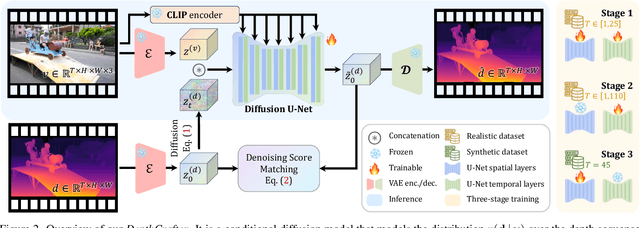

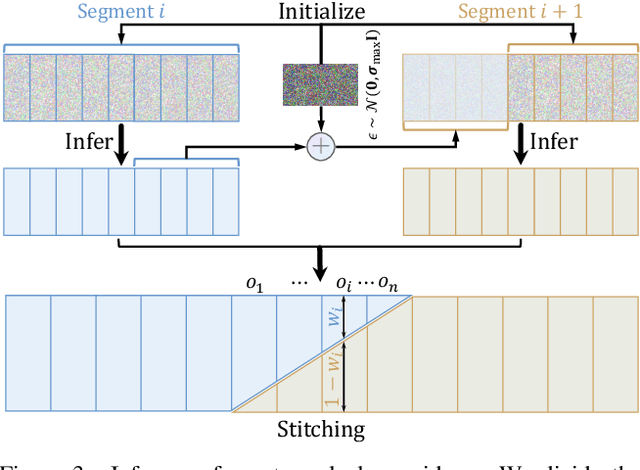
Abstract:Despite significant advancements in monocular depth estimation for static images, estimating video depth in the open world remains challenging, since open-world videos are extremely diverse in content, motion, camera movement, and length. We present DepthCrafter, an innovative method for generating temporally consistent long depth sequences with intricate details for open-world videos, without requiring any supplementary information such as camera poses or optical flow. DepthCrafter achieves generalization ability to open-world videos by training a video-to-depth model from a pre-trained image-to-video diffusion model, through our meticulously designed three-stage training strategy with the compiled paired video-depth datasets. Our training approach enables the model to generate depth sequences with variable lengths at one time, up to 110 frames, and harvest both precise depth details and rich content diversity from realistic and synthetic datasets. We also propose an inference strategy that processes extremely long videos through segment-wise estimation and seamless stitching. Comprehensive evaluations on multiple datasets reveal that DepthCrafter achieves state-of-the-art performance in open-world video depth estimation under zero-shot settings. Furthermore, DepthCrafter facilitates various downstream applications, including depth-based visual effects and conditional video generation.
MagicMan: Generative Novel View Synthesis of Humans with 3D-Aware Diffusion and Iterative Refinement
Aug 26, 2024
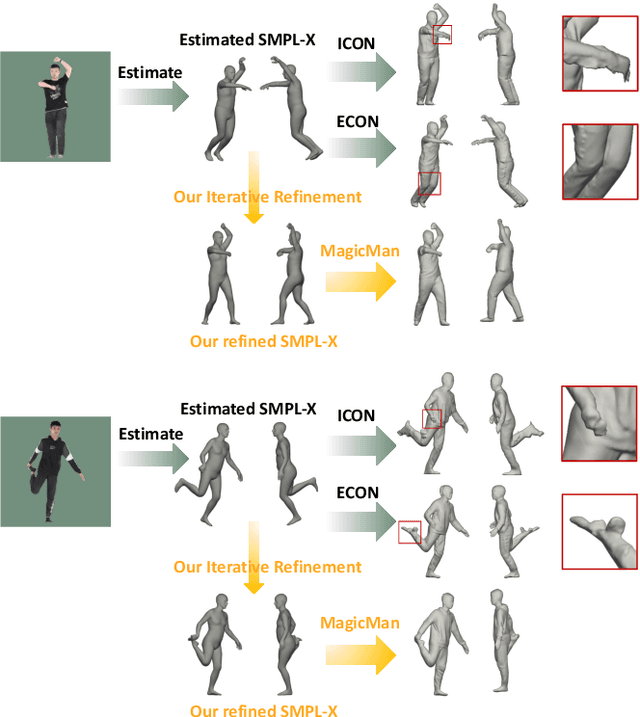
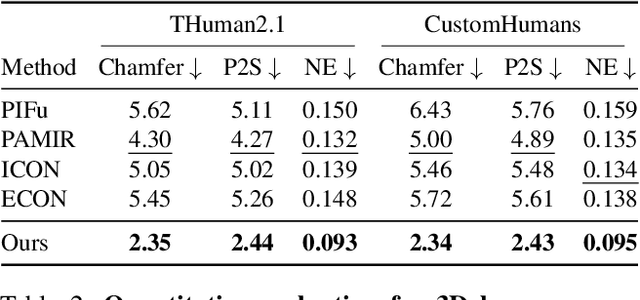
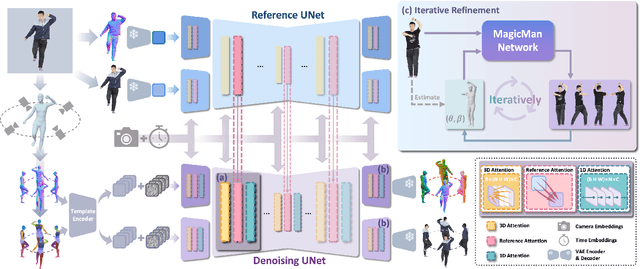
Abstract:Existing works in single-image human reconstruction suffer from weak generalizability due to insufficient training data or 3D inconsistencies for a lack of comprehensive multi-view knowledge. In this paper, we introduce MagicMan, a human-specific multi-view diffusion model designed to generate high-quality novel view images from a single reference image. As its core, we leverage a pre-trained 2D diffusion model as the generative prior for generalizability, with the parametric SMPL-X model as the 3D body prior to promote 3D awareness. To tackle the critical challenge of maintaining consistency while achieving dense multi-view generation for improved 3D human reconstruction, we first introduce hybrid multi-view attention to facilitate both efficient and thorough information interchange across different views. Additionally, we present a geometry-aware dual branch to perform concurrent generation in both RGB and normal domains, further enhancing consistency via geometry cues. Last but not least, to address ill-shaped issues arising from inaccurate SMPL-X estimation that conflicts with the reference image, we propose a novel iterative refinement strategy, which progressively optimizes SMPL-X accuracy while enhancing the quality and consistency of the generated multi-views. Extensive experimental results demonstrate that our method significantly outperforms existing approaches in both novel view synthesis and subsequent 3D human reconstruction tasks.
Mani-GS: Gaussian Splatting Manipulation with Triangular Mesh
May 28, 2024Abstract:Neural 3D representations such as Neural Radiance Fields (NeRF), excel at producing photo-realistic rendering results but lack the flexibility for manipulation and editing which is crucial for content creation. Previous works have attempted to address this issue by deforming a NeRF in canonical space or manipulating the radiance field based on an explicit mesh. However, manipulating NeRF is not highly controllable and requires a long training and inference time. With the emergence of 3D Gaussian Splatting (3DGS), extremely high-fidelity novel view synthesis can be achieved using an explicit point-based 3D representation with much faster training and rendering speed. However, there is still a lack of effective means to manipulate 3DGS freely while maintaining rendering quality. In this work, we aim to tackle the challenge of achieving manipulable photo-realistic rendering. We propose to utilize a triangular mesh to manipulate 3DGS directly with self-adaptation. This approach reduces the need to design various algorithms for different types of Gaussian manipulation. By utilizing a triangle shape-aware Gaussian binding and adapting method, we can achieve 3DGS manipulation and preserve high-fidelity rendering after manipulation. Our approach is capable of handling large deformations, local manipulations, and soft body simulations while keeping high-quality rendering. Furthermore, we demonstrate that our method is also effective with inaccurate meshes extracted from 3DGS. Experiments conducted demonstrate the effectiveness of our method and its superiority over baseline approaches.
ConTex-Human: Free-View Rendering of Human from a Single Image with Texture-Consistent Synthesis
Nov 28, 2023



Abstract:In this work, we propose a method to address the challenge of rendering a 3D human from a single image in a free-view manner. Some existing approaches could achieve this by using generalizable pixel-aligned implicit fields to reconstruct a textured mesh of a human or by employing a 2D diffusion model as guidance with the Score Distillation Sampling (SDS) method, to lift the 2D image into 3D space. However, a generalizable implicit field often results in an over-smooth texture field, while the SDS method tends to lead to a texture-inconsistent novel view with the input image. In this paper, we introduce a texture-consistent back view synthesis module that could transfer the reference image content to the back view through depth and text-guided attention injection. Moreover, to alleviate the color distortion that occurs in the side region, we propose a visibility-aware patch consistency regularization for texture mapping and refinement combined with the synthesized back view texture. With the above techniques, we could achieve high-fidelity and texture-consistent human rendering from a single image. Experiments conducted on both real and synthetic data demonstrate the effectiveness of our method and show that our approach outperforms previous baseline methods.
HiFi-123: Towards High-fidelity One Image to 3D Content Generation
Oct 10, 2023



Abstract:Recent advances in text-to-image diffusion models have enabled 3D generation from a single image. However, current image-to-3D methods often produce suboptimal results for novel views, with blurred textures and deviations from the reference image, limiting their practical applications. In this paper, we introduce HiFi-123, a method designed for high-fidelity and multi-view consistent 3D generation. Our contributions are twofold: First, we propose a reference-guided novel view enhancement technique that substantially reduces the quality gap between synthesized and reference views. Second, capitalizing on the novel view enhancement, we present a novel reference-guided state distillation loss. When incorporated into the optimization-based image-to-3D pipeline, our method significantly improves 3D generation quality, achieving state-of-the-art performance. Comprehensive evaluations demonstrate the effectiveness of our approach over existing methods, both qualitatively and quantitatively.
MPS-NeRF: Generalizable 3D Human Rendering from Multiview Images
Mar 31, 2022



Abstract:There has been rapid progress recently on 3D human rendering, including novel view synthesis and pose animation, based on the advances of neural radiance fields (NeRF). However, most existing methods focus on person-specific training and their training typically requires multi-view videos. This paper deals with a new challenging task -- rendering novel views and novel poses for a person unseen in training, using only multiview images as input. For this task, we propose a simple yet effective method to train a generalizable NeRF with multiview images as conditional input. The key ingredient is a dedicated representation combining a canonical NeRF and a volume deformation scheme. Using a canonical space enables our method to learn shared properties of human and easily generalize to different people. Volume deformation is used to connect the canonical space with input and target images and query image features for radiance and density prediction. We leverage the parametric 3D human model fitted on the input images to derive the deformation, which works quite well in practice when combined with our canonical NeRF. The experiments on both real and synthetic data with the novel view synthesis and pose animation tasks collectively demonstrate the efficacy of our method.
 Add to Chrome
Add to Chrome Add to Firefox
Add to Firefox Add to Edge
Add to Edge